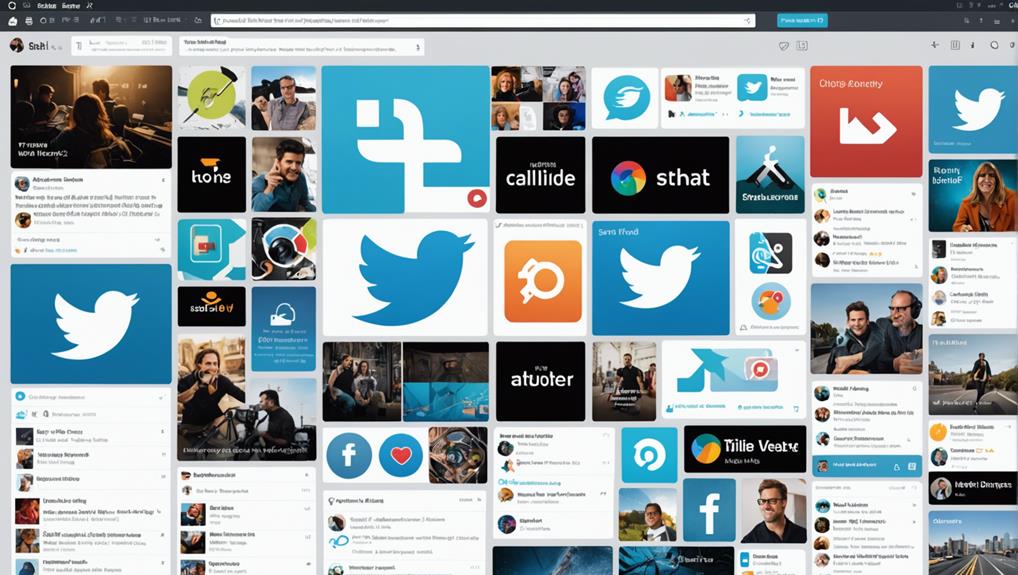To enhance your Twitter business content, strategically craft engaging tweets by integrating relevant hashtags and intriguing visuals. This approach boosts audience interaction, as tweets with images receive considerably higher engagement. Utilize Twitter Analytics to refine strategies and align content with audience behavior. Building a loyal follower base involves consistent engagement and collaboration with influencers. Leverage real-time tools like Twitter Spaces to foster authentic audience dialogues. Monitoring performance metrics and audience engagement trends provides data-driven insights that adapt content strategies effectively. Explore these elements to transform your Twitter content into a powerful vehicle for growth and engagement.
Key Takeaways
- Use relevant hashtags to double engagement and tap into larger conversations for increased visibility.
- Incorporate high-quality visuals and infographics to boost retweets and enhance storytelling.
- Analyze Twitter Analytics to refine content strategies and understand audience interaction patterns.
- Engage with followers through replies, retweets, and Twitter chats to build community and foster loyalty.
- Identify target audience demographics and interests using interactive tools and competitor analysis.
Crafting Engaging Tweets
Creating engaging tweets is an art that requires a strategic blend of elements to capture and maintain the attention of your audience. Crafting engaging tweets involves the integration of relevant hashtags, which can double audience engagement by making content discoverable.
Equally important are enthralling visuals, which enhance the tweet’s appeal and increase the likelihood of shares and interactions. In the domain of digital marketing, these components are indispensable for boosting social media marketing efforts.
Understanding the ideal timing of tweets is vital, as the average tweet lifespan is a mere 18 minutes. By aligning tweet schedules with audience activity peaks, businesses can maximize visibility and engagement.
Twitter Analytics is an invaluable tool in this scenario, offering insights into audience behavior and helping to refine content strategies. This data-driven approach enables the crafting of engaging content that resonates with followers.
A well-rounded Twitter strategy should include a mix of informational, humorous, and promotional tweets. This variety not only attracts a wider audience but also fosters meaningful interactions.
Emojis can further enhance engagement by conveying emotion succinctly. To sum up, crafting engaging tweets is integral to successful digital marketing and social media campaigns.
Harnessing the power of hashtags is a vital component in the orchestration of a successful Twitter strategy. By effectively utilizing both trending hashtags and niche tags, businesses can markedly amplify their audience engagement—potentially doubling interaction rates. Incorporating trending hashtags allows brands to tap into broader conversations, thereby enhancing visibility among target audiences. This practice not only increases immediate engagement but also guarantees that the content remains valuable and relevant in the ever-evolving social media landscape.
Crafting unique branded hashtags is another fundamental aspect, as it helps reinforce brand identity. These hashtags should resonate with the audience and align seamlessly with the overall messaging strategy. This personalized touch fosters a sense of community and loyalty, encouraging users to participate in the conversation more actively.
The strategic use of hashtags is further substantiated by statistics showing that tweets with at least one hashtag receive 55% more retweets. Regularly analyzing hashtag performance is essential in refining these strategies, guaranteeing that businesses remain connected to audience interests and continue to deliver valuable content.
Such insights enable companies to adapt their Twitter marketing strategy dynamically, maintaining relevance and fostering a thriving online presence.
Visual Content Strategies
Enhancing engagement on Twitter through the strategic use of visual content is an essential element of modern digital marketing. High-quality visuals have demonstrated their power in transforming a simple tweet into an engaging tweet, capable of garnering 150% more retweets than text-only posts. This underscores the necessity of integrating fascinating images into your Twitter feed to increase engagement effectively.
Infographics, in particular, have proven to be a standout in visual storytelling, receiving an impressive 832% more retweets than other content forms. Such data-driven visuals not only convey complex information succinctly but also capture the audience’s attention, fostering a deeper connection with the message.
Additionally, tweets that include images see a notable 94% boost in engagement, emphasizing the crucial role of visual content in effective communication.
To maximize impact, it’s important to optimize images according to Twitter’s recommended aspect ratio of 2:1 (1200×600 pixels). Additionally, incorporating faces in images can humanize content, making it more relatable and engaging.
As you refine your visual strategy, remember the significance of an appealing profile photo and the strategic use of hashtags to further enhance visibility and interaction on the platform.
Utilizing Twitter Analytics
Harnessing the power of Twitter Analytics is essential for businesses aiming to maximize their posting schedules and enhance content performance.
By closely examining the engagement metrics of tweets, companies can identify the ideal times to reach their audience, ensuring maximum visibility and interaction.
Additionally, analyzing the attributes of top-performing content provides valuable insights into audience preferences, enabling brands to refine their strategies for more effective communication and sustained growth.
Optimize Posting Schedule
Understanding the ideal posting schedule is imperative for maximizing the impact of your Twitter business content. Leveraging Twitter Analytics provides access to key metrics such as engagement rates and impressions, essential for determining ideal posting times. By analyzing audience behavior, businesses can identify peak engagement hours, making sure that tweets are published when followers are most active. This strategic scheduling enhances visibility and interaction, significant for expanding your reach effectively.
Monitoring your top-performing tweets offers insights into which content and posting times yield the highest engagement. By adjusting your posting frequency, based on these analytics, aiming for 3-5 tweets per day, you can maximize exposure within the average tweet lifespan of just 18 minutes. This approach guarantees that your content remains relevant and resonates with your audience.
Moreover, regular reviews and adaptations of your posting schedule based on real-time performance data from Twitter Analytics are critical. This ongoing evaluation helps maintain relevance and engagement, adapting to any shifts in audience behavior.
Through the strategic utilization of Twitter Analytics, businesses can refine their posting schedule, making sure that their content not only reaches but genuinely connects with their target audience.
Analyze Content Performance
Effectively analyzing content performance on Twitter can transform your business’s social media strategy. Twitter Analytics is an invaluable tool that provides insights into tweet performance, offering businesses the ability to measure content effectiveness through metrics like impressions, engagements, clicks, and retweets. By examining these data points, businesses can identify which tweets resonate most with their audience, thereby enabling them to refine content and improve overall engagement.
Understanding audience demographics through Twitter Analytics allows businesses to tailor their content to align with the preferences and behaviors of their target groups. This strategic alignment enhances connection and boosts engagement rates, which are essential metrics indicating the percentage of interactions relative to views. Monitoring these rates helps businesses assess content effectiveness and make necessary data-driven adjustments.
Moreover, evaluating hashtag performance is vital in understanding which tags yield the highest engagement, allowing for strategic refinement in their usage. By identifying top-performing tweets and hashtags, businesses can optimize their posting strategies, ensuring that content is shared at the most opportune times and in the most engaging formats.
Regularly leveraging Twitter Analytics empowers businesses to not only track performance but also make informed, strategic decisions in their social media efforts.
Building a Follower Base
Building a robust follower base on Twitter requires a strategic approach that begins with identifying and understanding your target audience to tailor content that truly resonates.
Incorporating strategic hashtag utilization can amplify your reach, as evidenced by the 55% increase in retweets for tagged tweets, while consistent engagement practices such as replies and retweets foster a loyal community.
Regularly evaluating metrics related to follower growth and engagement enables businesses to refine their strategies, ensuring sustained visibility and connection with their audience.
Target Audience Identification
Identifying your target audience is an important step in building a successful Twitter presence for your business. Conducting thorough research into your audience’s demographics, interests, and behaviors enables you to develop a content strategy that truly resonates.
Engaging with your audience through interactive tools such as polls and surveys can provide valuable insights into their preferences, allowing you to refine your content to better meet their needs.
Leveraging Twitter Analytics is essential in this process, as it offers a detailed view of follower growth and engagement metrics. This data helps in crafting audience personas that reflect the diverse segments of your target market, ensuring your messaging aligns with their specific interests.
By analyzing these metrics, you gain a clearer understanding of what content your audience finds compelling, which is crucial for maintaining their interest and loyalty.
Moreover, monitoring competitor activity can uncover potential audience segments that may be engaging with similar brands. Observing what content drives interaction in these spaces can provide additional guidance for your strategy.
Strategic Hashtag Utilization
Harnessing the power of strategic hashtag utilization is a pivotal element in expanding your Twitter business presence and building a robust follower base. By incorporating relevant hashtags, tweet visibility can increase by 55%, allowing your message to reach a broader audience.
This practice is not only about visibility but also about fostering engagement and enhancing brand recognition. Crafting unique branded hashtags that resonate with your audience can categorize your content effectively, encouraging user-generated content which further strengthens your brand’s image.
Engaging with trending hashtags can greatly amplify your reach, tapping into broader conversations and potentially doubling tweet engagement. However, the key lies in analyzing hashtag performance to refine your strategy. Insights from such analysis reveal that tweets with the right hashtags see a 100% increase in engagement, underscoring the importance of strategic refinement.
To optimize discoverability and build a loyal follower base, a balanced mix of trending and unique hashtags is essential. This approach guarantees your content stands out amidst the digital noise.
Consider these strategies:
- Utilize relevant hashtags to boost tweet visibility.
- Develop unique hashtags for enhanced brand recognition.
- Engage with trending hashtags for increased engagement.
Consistent Engagement Practices
A thriving Twitter community serves as the cornerstone of a successful business presence on the platform, and consistent engagement practices are fundamental to cultivating this foundation.
Consistent interaction with followers, such as promptly responding to comments and direct messages, fosters a community feeling, enhancing audience loyalty. This loyalty is further bolstered by maintaining visibility through tweeting 3-5 times daily, given that an average tweet’s lifespan is merely 18 minutes. This frequency guarantees that businesses capitalize on every engagement opportunity.
Strategic hashtags play a significant role in this equation, increasing retweets by 55% and doubling overall engagement. This expanded reach is essential for growing a robust follower base.
Additionally, engaging with user-generated content, through actions like retweeting customer reviews and photos, not only builds trust but also encourages more followers to share their experiences, amplifying participation.
Moreover, hosting regular Twitter chats or contests is an effective strategy to stimulate dialogue and increase participation, thereby organically augmenting your follower base.
These interactions are instrumental in crafting a dynamic Twitter presence, securing sustained engagement and a thriving community that supports business growth.
Twitter for Business Benefits
Among the multitude of platforms available for business engagement, Twitter stands out for its real-time interaction capabilities, which are paramount for improving customer satisfaction and loyalty.
With over 500 million active users, Twitter offers an expansive audience that can greatly boost brand visibility. The platform’s ability to facilitate direct dialogue allows brands to engage in conversations that not only address customer inquiries but also foster a 68% increase in customer satisfaction.
This interaction is essential for crafting effective promotional campaigns that have been shown to raise purchase intent by 34% among engaged users.
Monitoring industry trends and relevant topics on Twitter provides businesses with insights necessary to adapt their offerings and tailor marketing strategies, ensuring they remain competitive and relevant.
By leveraging real-time interaction, companies can swiftly respond to customer feedback, enhancing their reputation and fostering trust.
Key benefits of using Twitter for business include:
- Improving brand visibility through a vast and active user base.
- Increasing customer satisfaction by actively engaging in conversations and addressing feedback.
- Boosting purchase intent via targeted promotional campaigns that resonate with engaged users.
Setting Up a Business Account
Establishing a strong presence on Twitter begins with the meticulous setup of a business account, an essential step that sets the foundation for effective engagement. The process commences at Twitter.com, where selecting a memorable username that encapsulates your brand identity is critical.
Your Twitter account should reflect professionalism, beginning with a high-quality company logo as the profile photo. This, along with a visually striking header image that resonates with your business offerings, creates an inviting profile.
Crafting an impactful bio within the 160-character limit is significant. This section should succinctly convey essential details, such as your location and business hours, while integrating a link to your website to facilitate easy access for potential customers.
Converting your Twitter account to a Professional Account releases additional features designed to enhance business engagement, providing tools to better connect with your audience.
Maximizing visibility is fundamental; pinning a tweet that showcases your key offerings or significant announcements guarantees this. Such strategic placement at the top of your profile amplifies the message’s reach and impact, ensuring it captures the audience’s attention.
This thoughtful setup fosters a robust foundation for your business on Twitter.
Monitoring Performance
Understanding is the cornerstone of optimizing your Twitter business strategy, and monitoring performance is essential to this process. By leveraging Twitter Analytics, businesses can gain pivotal insights into key metrics such as impressions, engagements, clicks, and retweets, each of which contributes to a thorough picture of tweet performance.
These metrics are instrumental in evaluating content effectiveness and refining communication strategies. Engagement rates, representing the ratio of interactions to views, are particularly telling of audience interest. By closely monitoring these rates, businesses can fine-tune their content to better align with audience preferences.
Additionally, tracking follower growth trends provides valuable information for enhancing community engagement and ensuring content resonates with the audience. Analyzing hashtag performance is another critical component of monitoring Twitter activity. Identifying which hashtags drive the most interaction allows businesses to strategically employ them in future content, optimizing for maximum engagement.
- Track sentiment analysis to adapt communication strategies that match audience preferences.
- Use insights from Twitter Analytics to adjust content and boost tweet performance.
- Monitor follower growth to strengthen community engagement and content resonance.
Tools for Enhanced Engagement
To enhance your Twitter presence, leveraging the right tools for improved engagement is essential. Twitter Spaces offers an innovative platform for hosting live audio conversations, enabling real-time interaction and fostering deeper connections with your audience and industry experts.
This dynamic engagement tool not only raises your brand presence but also facilitates authentic dialogue, enhancing your brand’s relatability and trust.
Twitter Lists provide a methodical approach to organizing your feed, allowing you to efficiently track influencers, competitors, and important industry conversations. This strategic organization supports a well-informed content strategy, ensuring your engagement efforts are targeted and effective.
Additionally, employing polls on Twitter can greatly boost engagement by inviting audience feedback and sparking meaningful discussions, which can inform future content and strategic direction.
To refine your approach, tools like Sprout Social offer invaluable audience behavior insights, allowing you to adjust your content strategy based on empirical data.
Social monitoring tools play an essential role in tracking brand sentiment and online mentions, providing a clear understanding of customer concerns and perceptions.
Frequently Asked Questions
How Can I Handle Negative Comments or Criticism on Twitter Professionally?
Handling negative comments professionally on Twitter requires a response strategy focusing on conflict resolution and emotional intelligence. Employ constructive feedback and authenticity in communication to protect brand reputation, while utilizing public relations and crisis management tactics to enhance customer service and engagement.
What Is the Best Time to Post Tweets for Maximum Visibility?
Determining the ideal posting time involves analyzing audience demographics, tweet engagement, and time zones. Utilize analytics tools and competitor analysis to identify peak hours, while considering industry trends, content scheduling, and seasonal patterns for maximum visibility.
How Often Should I Tweet Daily to Maintain Audience Engagement?
Determining ideal tweet frequency requires analyzing audience insights and engagement metrics. Utilize scheduling tools to maintain content variety and align with industry trends. Monitor analytics tracking and peak activity to enhance interaction rates, follower growth, and sustained engagement.
How Do I Craft a Compelling Twitter Bio for My Business?
Crafting a compelling Twitter bio requires aligning with your brand personality and target audience. Emphasize unique value with a clear call to action, include relevant keywords, guarantee tone consistency, and incorporate visual elements, adhering to character limits and updating frequently.
What Are Effective Strategies for Collaborating With Influencers on Twitter?
To effectively collaborate with influencers on Twitter, focus on influencer outreach, ensuring audience alignment through brand partnerships. Prioritize content co-creation, trust building, and engagement metrics, while employing hashtag strategy, cross-promotion tactics, campaign planning, and fostering long-term relationships.
Conclusion
To summarize, optimizing Twitter for business requires a strategic approach encompassing engaging content creation, effective hashtag utilization, and robust visual strategies. Analyzing performance through Twitter Analytics provides critical insights into audience behavior, facilitating data-driven decisions. Establishing a strong follower base and understanding the platform’s unique benefits enhances business presence. Setting up a dedicated business account and employing specialized tools further augments engagement. These elements collectively contribute to an all-encompassing strategy for maximizing Twitter’s potential as a dynamic business platform.




